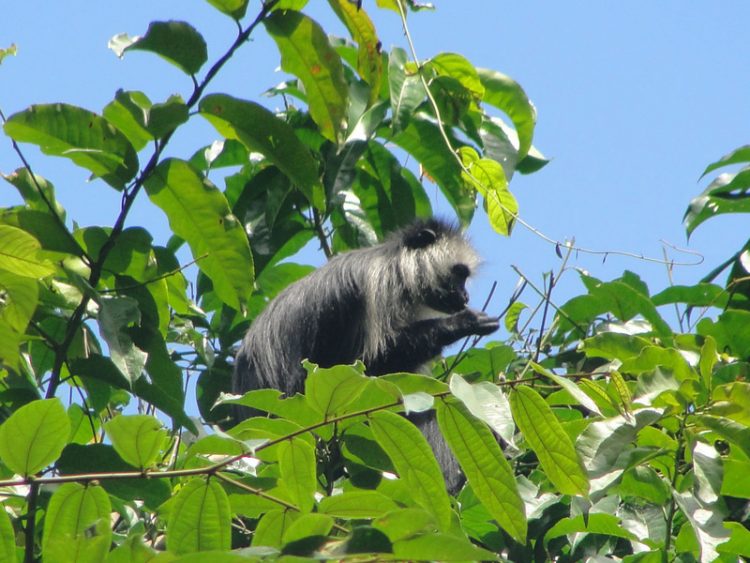Eavesdropping on the forest to monitor wildlife

The loud calls of the king colobus monkey, also known as the black and white colobus, performed best in this study. © MPI for Evolutionary Anthropology / Ammie Kalan
Traditionally, censusing of wild primates has been conducted using transect methodology where teams of human surveyors walk kilometers of line transects to collect data on primate sightings and vocalizations.
Motivated by the increasing availability of cost-efficient audio-visual technologies, researchers at the Max Planck Institute for Evolutionary Anthropology in Leipzig, and the Fraunhofer Institute for Digital Media Technology (IDMT) in Ilmenau, investigated to what extent autonomous recording devices, combined with an automated data processing approach, could be used to monitor wild forest primates.
To achieve this goal they used an interdisciplinary team of sound engineers, biomonitoring specialists, statisticians, and primate vocalization experts.
A system was developed in collaboration with the Fraunhofer IDMT, to automatically scan large amounts of continuous audio data to isolate sound signals produced by chimpanzees and two other primate species living in the tropical rainforest of Taï National Park in Côte d’Ivoire. The researchers used autonomous recording devices (ARUs) produced by the company Wildlife Acoustics. First, a training library of annotated primate sounds was compiled.
“The algorithm was then developed to scan forest recordings and automatically detect and classify the chimpanzee buttress drumming sound and the loud calls of the diana monkey and king colobus monkey”, says Ammie Kalan, the project leader.
The researchers then applied this algorithm and verified how often it falsely detected a call (false positive) or failed to correctly identify a call (false negative). Using an occupancy modeling approach, they then derived occupancy probabilities for each of the three primate species, also known as the probability with which a species is present in a given study area.
The occupancy probability estimates derived from PAM data approximated those obtained from point transects conducted in the same area by humans. In particular, the longitudinal data obtained using PAM appeared to be especially beneficial for accurately detecting chimpanzees since they are cryptic and often remain quiet when in the presence of humans.
For all three species, probabilities were robust to the automated PAM data but some degree of manually verifying the automated output was still required. Nevertheless, the time effort required to clean some of the data manually was still considerably less than the time investment for walking transects.
“Our results show that for the best performing species with this system, the king colobus monkey, accurate occupancy probabilities could be derived by just cleaning 90% of the false positives, which translates to 23 minutes for 179 hours of audio data”, says Ammie Kalan.
“This study only shows the first step that is possible with this method. In principle, the system could be used for long-term monitoring whereby changes in presence or detection rates could be used as an early warning system to alert field managers and to help them respond to threats”, says project supervisor Hjalmar Kühl.
“The importance in using autonomous data collection devices, such as ARUs, along with automated data processing methods lies in obtaining data about wild animals closer to real-time rather than months or years later. Field workers can then react more quickly, allowing interventions to become more effective”, says Ammie Kalan.
The authors hope this study will motivate further cross-disciplinary research into PAM and its potential to aid field workers in managing the last strongholds of endangered primate populations, as well as other taxa.
Contact
Ammie KalanMax Planck Institute for Evolutionary Anthropology, Leipzig
Phone: +49 341 3550-205 Email: ammie_kalan@eva.mpg.de Dr. Hjalmar Kühl
Max Planck Institute for Evolutionary Anthropology, Leipzig
Phone: +49 341 3550236 Fax: +49 341 3550299 Email: kuehl@eva.mpg.de Sandra Jacob
Press and Public Relations Max Planck Institute for Evolutionary Anthropology, Leipzig
Phone: +49 341 3550-122 Fax: +49 341 3550-119 Email: info@eva.mpg.de
Original publication
Ammie K. Kalan, Roger Mundry, Oliver J.J. Wagner, Stefanie Heinicke, Christophe Boesch, and Hjalmar S. Kühl
Towards the automated detection and occupancy estimation of primates using passive acoustic monitoring
Ecological Indicators, 18 March 2015, DOI: 10.1016/j.ecolind.2015.02.023
Media Contact
All latest news from the category: Life Sciences and Chemistry
Articles and reports from the Life Sciences and chemistry area deal with applied and basic research into modern biology, chemistry and human medicine.
Valuable information can be found on a range of life sciences fields including bacteriology, biochemistry, bionics, bioinformatics, biophysics, biotechnology, genetics, geobotany, human biology, marine biology, microbiology, molecular biology, cellular biology, zoology, bioinorganic chemistry, microchemistry and environmental chemistry.
Newest articles

Properties of new materials for microchips
… can now be measured well. Reseachers of Delft University of Technology demonstrated measuring performance properties of ultrathin silicon membranes. Making ever smaller and more powerful chips requires new ultrathin…

Floating solar’s potential
… to support sustainable development by addressing climate, water, and energy goals holistically. A new study published this week in Nature Energy raises the potential for floating solar photovoltaics (FPV)…

Skyrmions move at record speeds
… a step towards the computing of the future. An international research team led by scientists from the CNRS1 has discovered that the magnetic nanobubbles2 known as skyrmions can be…





















